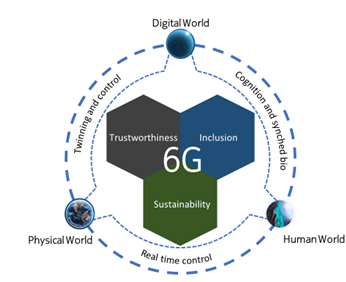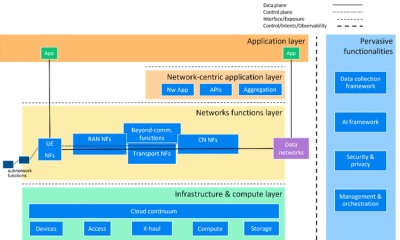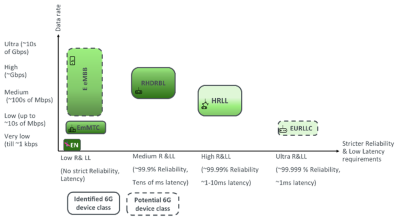Mikko A. Uusitalo, Hamed Farhadi, Patrik Rugeland, and Mauro Boldi
Published: 30 Jan 2024

CTN Issue: January 2024
A note from the editor:
Over the last couple of years, we have used the January edition of CTN to look ahead and try to predict the technologies or trends that would garner attention or perhaps become mainstream. In 2022 we talked about AI becoming mainstream, well we missed that prediction by a year but who is keeping tabs? In 2023 we ventured into the world of the magic 8 ball to see if the famous fortune teller toy was able to help us with our predictions. I am happy to say that the fortune teller did quite well: of the six predictions we posted in January of 2023, we can argue that all of them hit the target in one way or another. Integrated Communications and Sense (ISAC) became a much talked about subject and it is now making its way into the wireless standards arena with AI becoming a strong partner of ISAC. The sky was very friendly to us as NTN continued its strong mind share gain including 5G native satellite testing taking place, 2024 will continue to see its growth. IoT “disappeared” as predicted, since it has started to weave itself into the fabric of everyday life. Just see what transpired at CES this year, this disappearance act is likely to have a bigger follow up in the upcoming years. Red-cap device 3GPP standardization was finalized in 2023 and vendors are announcing chipsets and modules to support devices and solutions based on Red-cap, it is gaining important momentum to support many 5G verticals. We predicted that fiber to the home will continue to see major gains in 2023. This is certainly the case in many geographies, and it is an indispensable technology for many high-end services. We also predicted that in 2023 RIS in many of its incarnations (Intelligent Reflective Surfaces, Smart Repeaters, Large Intelligent Surfaces, etc.), would see a broader industrial engagement with more defined use cases and solutions proposed, aimed at future commercialization of the RIS technology. This is indeed the case, research on RIS continues and 6G study groups and forums have selected RIS as one of its core technologies. Finally, we watched WRC-23 take place and happily see many commonsense agreements, it is clear that the industrial and economic success of wireless based technologies will hinge on spectrum availability more so perhaps than any other technological challenge.
For this year’s January article, we will shy away from predictions and will cede the stage to an article from the Hexa X and Hexa X II project titled “Hexa-X laying the foundation for 6G and Hexa-X-II paving the road to 6G systemization”. It is in some respects a predictive article as it dives into the world of 6G, its vision and the enablers that will shape it. We want to thank the authors for this timely contribution to CTN.
CTN Editorial Board
Hexa-X Laying the Foundation for 6G and Hexa-X-II Paving the Road to 6G Systemization




Abstract
This article outlines the global landscape of research initiatives driving the next generation of wireless communication. Focusing on the European front, it provides an overview of the Hexa-X and Hexa-X-II projects—flagship 6G projects. The article explores the vision, key objectives, and potential impact of these initiatives, shedding light on the collaborative efforts shaping the future of connectivity.
I. Motivation for 6G
Cellular technologies have developed via generations over roughly 10-year cycles. Constantly, year by year and decade by decade, increasing demand and additional requirements on earlier generations and new performance have pushed the technology forward. There have been use cases that have not yet been fulfilled as well as new use cases which are proposed. 6G needs to address the new requirements and at the same time fulfill value-based requirements on trustworthiness, inclusiveness, and sustainability.
II. 6G Research Landscape
The race for research and industrial leadership in 6G networks, with profound implications for society, the economy, and geopolitics, has been ongoing already for some years. Figure 1 provides a visual overview of the significant activities in the 6G landscape. Notably, the International Telecommunication Union (ITU) established a focus group on technologies for network 2030 in 2018 and ITU-R Working Party (WP) 5D initiated the work on future technology trends in 2020, followed by framework work in 2021 for IMT (International Mobile Telecommunications) for 2030 and beyond. The future technology trends report was released in December 2022, and the framework recommendation is expected in 2023. Furthermore, the Next Generation Mobile Networks (NGMN) alliance initiated a project focused on visions and drivers for 6G in October 2020. Their first deliverable in this project was published in April 2021 [1].

In Europe, significant steps have been made in 6G research. The world's first national 6G program, 6G Flagship, was established at the University of Oulu in 2018 supported by the Academy of Finland. Subsequently, in January 2021, nine EU 6G projects, with Hexa-X as the 6G Flagship project [2], commenced under the last call of Horizon 2020, contributing to exploratory research and laying the groundwork for 6G. Furthermore, Europe, building upon the achievements and insights gained from the 5G-PPP activities in Horizon 2020, launched a renewed European-level private-public partnership under the 2021-2027 European Research Framework Program, Horizon Europe. This partnership, Smart Networks and Services Joint Undertaking (SNS JU), focuses on research and innovation extending beyond 5G and towards 6G. In the fall of 2022, SNS JU announced the initiation of 35 new projects in 2023, with the next 6G Flagship, Hexa-X-II [3], being among them. Various European countries have also been actively engaged in 6G initiatives, with noteworthy examples including the lighthouse project 6G-ANNA and other national projects in Germany. Additionally, recognizing the importance of strengthening Europe's industry position and competence in connectivity chip design, the COREnect initiative, a cross-industry effort that brought together major players in European microelectronics, was successfully completed in June 2022. This initiative has produced an industry roadmap with detailed strategic actions aimed at reducing Europe's reliance on other continents for electronic subsystems and components, particularly in the context of 6G development [4].
Beyond Europe, notable developments have been occurring in the United States. In March 2020, the U.S. administration introduced the "Secure 5G and Beyond Act," officially declaring its commitment to collaborating with the private sector to advance the evolution and security of 5G networks. Furthermore, on October 13, 2020, the Alliance for Telecommunications Industry Solutions (ATIS) launched the Next G Alliance [5], an industry initiative comprising 16 founding members. In conjunction with this effort, the U.S. National Science Foundation (NSF), in collaboration with other federal agencies and private industry partners, established the Resilient and Intelligent Next-Generation Systems (RINGS) program. RINGS aims to expedite research in areas that could have a substantial impact on the development of Next-Generation (NextG) networking and computing systems. These initiatives reflect a concerted effort in the U.S. to play a prominent role in shaping the future of communication technologies, including 6G.
Across the globe, various organizations and nations are actively engaged in shaping the future of 6G and beyond. In China, a consortium of vendors, operators, and academia collaboratively formed the IMT-2030(6G) Promotion Group, fostering a strong presence. In Japan, the Beyond 5G Promotion Consortium (B5GPC) was established in 2020 as a platform for industry, academia, and government to exchange information on international trends, discuss initiatives for early realization of Beyond 5G, and promote Japan's initiatives related to Beyond 5G on a global scale. The Korean government has unveiled an ambitious 6G research and development strategy with the aim of achieving "World's first 6G commercialization." National R&D projects were initiated in August 2020, and technology trials are planned for 2026, with commercial services targeted for 2028. In India, the Telecommunications Standards Development Society (TSDSI) has embarked on a 6G initiative, focusing on use cases and requirements for 6G. In addition, the Indian Department of Telecommunication launched the Bharat 6G Alliance in 2022. Their strategy encompasses driving research in India to align with 6G objectives and maintaining engagement with global standard bodies for harmonization. These initiatives reflect a global commitment to advancing 6G technology and standards.
1. Hexa-X and Hexa-X-II Projects’ Overview
The European 6G flagship project Hexa-X was established as part of the 5G-PPP activities in Horizon 2020 by bringing together the key industry stakeholders, along with the full value-chain of future connectivity solutions ranging from network vendors (Nokia and Ericsson), operators (TIM, Orange, Telefonica), verticals, and technology providers (e.g., software and Internet of Things (IoT) solutions), as well as the most prominent European research institutes and universities in this domain, streamlining expert forces and creating a critical mass to lead an integrated effort of research and development towards 6G. The Consortium was composed of 25 organizations. Nokia was the overall lead and Ericsson the technical manager. Other three large ICT industries (Siemens, Atos, Intel) complemented the industry group by bringing in essential capabilities on AI, network orchestration, and special purpose solutions. Academic and research organizations participating in Hexa-X provided the necessary scientific excellence and research in 6G topics that strengthened the technological impact of the project’s output. Finally, the involved SMEs provided necessary skills in orchestration, AI, and channel modelling to ensure viability of the Hexa-X solutions. All Hexa-X participants have been at the center of national and international strategic innovation initiatives, including 5G PPP Phase I/II/III projects. Hexa-X has laid the foundation for the global communication network of the 2030s by developing the 6G vision and basic concepts, including candidate key technology enablers, and the draft of the end-to-end architecture.
The European 6G Flagship project Hexa-X-II receives funding via the Smart Network and Services Joint Undertaking (SNS JU). The project leads the way to the end-to-end (E2E) system design (based on integrated and interacting technology enablers) and the enabling platform delivering novel services for the next generation (6G) of wireless networks. The project will continue on the tracks of the Horizon Europe project Hexa-X.
The work in Hexa-X-II expands from research to systemization analysis, early validation, and proof of concept. It progresses from the 6G key enablers that connect the human, physical, and digital worlds to advanced technology readiness – validated technology – including key aspects of modules, protocols and interfaces, and data. Hexa-X-II will design a system blueprint aiming at the sustainable, inclusive, and trustworthy 6G platform that should meet the future needs of serving and transforming society and business. The Consortium is composed of 44 organizations. The overall lead is Nokia and Ericsson is technical manager.
III. 6G VISION
Hexa-X vision for 6G revolves around the integration and enhancement of interactions among three worlds: the human world (encompassing human senses, bodies, intelligence, and values), the digital world (comprising information, communication, and computing), and the physical world (encompassing objects and organisms). The aim is to seamlessly bridge these worlds, unlocking new use cases and services that benefit individuals, enterprises, and societies.
Interactions between the digital and physical worlds facilitate the creation of digital twins of the physical world, using rich sensor data for deep analysis and enabling intelligent agents to act in the real world. These actions enhance efficiency, resilience, and preemptive maintenance. This convergence demands extensive communication. Interactions between the human and physical worlds enable efficient control and feedback through human-machine interfaces. Interactions between the human and digital worlds empower AI assistance and fully immersive communication among people. Collecting and syncing information on human well-being allows for applications like preventive healthcare.

At the heart of this vision are key values including trustworthiness, inclusiveness, and sustainability. These values guide the ambitions for 6G, aiming for it to be a societal backbone, universally accessible, and a significant driver of global development in environmental, social, and economic aspects. This transformative interplay between technology and society is poised to generate unparalleled opportunities for economic growth and contribute to addressing societal challenges as we approach the 2030s and beyond. Figure 2 shows Hexa-X 6G vision illustrating the interactions between these three worlds and the key values that 6G need to address.
To realize this vision, Hexa-X acknowledges the necessity of transitioning from a focus on performance-driven network design to one centered around values. This involves considering intangible yet vital human and societal considerations, including sustainability, trustworthiness, and inclusiveness. To address these aspects not covered by traditional key performance indicators (KPIs), Hexa-X has introduced a novel set of evaluation criteria, known as key value indicators (KVIs) [6]. These KVIs are intended to capture dimensions related to sustainability, trustworthiness, and inclusiveness. The aim is for KVIs to complement KPIs in the design and assessment of 6G networks. Moreover, this shift will necessitate a fundamental rethinking of how mobile networks are conceptualized and structured. Multiple critical requirements must be harmonized, catering to the escalating data demands and the proliferation of devices, sub-networks, and markets, all while enhancing energy efficiency, and fulfilling the highest requirements on security, privacy, and trust. This effort entails optimizing deployment efficiency for broader coverage, densification, and specialized operations to foster sustainable growth and innovation across various sectors. Hexa-X developed technological enablers for 6G radio, network architectures, AI-native networks, and orchestration and management of the network, and laid the draft E2E architecture. To continue the development of 6G, the Hexa-X-II project will continue the research on technological components for 6G, and define a 6G E2E system to realize the vision laid out by Hexa-X. The 6G system will go beyond the capabilities and purpose of the previous generations and will act as a platform to not only deliver communication services, but also beyond-communication services such as sensing and spatial data, computational offloading, as well as integrated AI services. To achieve these goals, the 6G system will need to allow exposure of capabilities, functions, and services well beyond what is possible in today’s networks.
III. Value Based Design
Starting from the KVIs defined in Hexa-X [6], the 6G system will be designed considering both the performance requirements, as well as the value requirements. In many cases, these requirements may be contradictory, e.g., maximize bitrate while minimizing energy consumption, or provide novel 6G services with extreme performance requirements while fostering digital inclusion for all. It will be important to design the 6G system to be flexible and dynamic to address these disparate scenarios, while at the same time be transparent to identify the parameters to tune as well as be efficient to scale the capabilities where needed and to allow automation and optimization where necessary. Furthermore, security, privacy, resilience and availability must be ensured and should be implemented at all levels of the system. Finally, the sustainability aspects, with environmental, social, and economic sustainability in focus, must be considered, which are essential to minimize the environmental footprint in terms of energy consumption, material circularity, and ecological impact, as well as to enable social and economic sustainability.
IV. Overview of 6G Enablers
Mobile networks continuously evolve but each new generation provides an opportunity to implement larger changes that may not be backward compatible. Towards 6G, research is ongoing on many different technological components and enablers. Some of these could, once sufficiently mature, be integrated into 5G Advanced, while some others may call for more radical changes to the overall system.
6G Radio Enablers:
To address the requirements for increased bandwidth for 6G, the Hexa-X and Hexa-X-II projects have explored several enhancements to the radio interface in terms of utilizing additional frequency ranges, such as the centimeter-wave range (7-15 GHz) and the sub-THz range (100-300 GHz) [7]. The centimeter-wave range is considered as a great complement to the existing bands by providing additional bandwidth at carrier frequencies with propagation characteristics and coverage similar to lower bands. The sub-THz range can offer unprecedented bandwidths in very specific scenarios, e.g., with short-range or line-of-sight deployments. Hexa-X developed models for material and wave interactions based on material permittivity and conductivity measurements for a variety of materials in the frequency range of 2GHz to 260 GHz and developed channel models at 140 GHz. Hexa-X-II projects continue channel modeling at high frequency bands. Hexa-X developed waveforms [8], and beamforming techniques for the sub-THz range [7], and the work towards novel waveforms and beamforming continues in Hexa-X-II [9]. Considering the maturity level of the radio hardware at sub-THz frequency range and the limited coverage which can be supported with this technology, it is not expected to be part of the 6G in the first phase of 6G. The centimeter-wave range can be utilized in 6G to fulfill the need for higher capacity to meet the needs for increasing traffic and higher accuracy for localization at relatively large coverage areas. In Release 19, 3GPP planned a study focusing on channel modeling to verify 3GPP channel models in the range of 7 to 24 GHz particularly looking into support for new 6G spectrum in the cm-wave range.
In addition, a new deployment option which is considered for 6G is based on distributed MIMO (D-MIMO), where non-collocated antenna elements jointly transmit and receive signals to specific UEs. This technique is promising to improve the coverage by circumventing blockages, as well as increasing network capacity as it would allow for cheaper and denser deployments closer to the UEs [7], [9]. Furthermore, 6G is envisioned to enable ultra-low power devices, e.g., capable of operating indefinitely without battery replacements through energy harvesting [10]. Due to the miniscule amount of energy available, the hardware and communication protocols must be revised to enable operation at such regimes. D-MIMO has been already considered in 3GPP standardizations and solutions as added in Release 18 and 19 for 5G advanced, creating precursors for D-MIMO in 6G.
Another important 6G aspect is Joint Communication and Sensing (JCAS). Historically, radio signals have been used for either communication, or for sensing (i.e., radars). With the application of higher carrier frequencies for communication networks, the spatial resolution of the signals become sufficient to be an attractive option to explore. JCAS could either be utilizing the same signals to simultaneously communicate and sense the environment; to only use the same type of hardware for communication and sensing; or something in-between. Once the network has collected the sensing data, this has to be processed and delivered to whoever would request the data, providing the opportunity to utilize the data for network optimizations, or to provide further enhanced sensor data by combining it with other sensing capabilities (e.g., radar, lidar, or cameras) to enable new use cases. Hexa-X proposed novel methods, signal design, architecture, and use cases for JCAS [11] and the work towards further enhancements of JCAS from key perspectives including JCAS architectures, waveforms and resource allocation, and security and privacy and its integration in cellular networks continues in Hexa-X-II [9]. Study for channel modeling for JCAS already planned in 3GPP Release 19 for 5G advanced which would provide the base for further studies and specifications in 6G.
AI/ML Enablers:
The rapid development and proliferation of artificial intelligence (AI) and machine learning (ML) are bound to have a significant impact on the 6G system [12], [13]. For instance, it would be possible to employ closed-loop or distributed AI models in the network to locally optimize the performance. The optimization could be a dynamic adaptation of the waveform, based on the specific radio conditions on the link. Alternatively, it could be implemented at higher layer, in the management layer, to dynamically allocate and orchestrate resources and achieve a zero-touch operation [14], [15]. Another aspect is intent-based management, where a human operator would simply request what the 6G system should achieve, and AI models would interpret and execute the necessary actions to achieve it.
In addition, network compute functionalities can be utilized to provide operators and end-users AI functionality as a service (AIaaS). Hexa-X proposed several AI/ML-based methods for radio access network (RAN) performance enhancements [12], [13], including the ones for waveform learning [16], power amplifier non-linearity compensation [17], beam selection for D-MIMO, channel coding, and beamforming. In Release 18, 3GPP explored the potential of AI and ML to enhance the capabilities and efficiency of the 5G air interface. The exploration was centered around three primary applications: improving localization accuracy, optimizing beam management, and refining Channel State Information (CSI) reporting. Moving forward, Release 19 aims to specify a framework for integrating AI/ML within the air interface, with particular attention to supporting applications such as precise positioning and effective beam management. AI and ML are anticipated to be pivotal in the evolution of technology and are projected to be integral to the infrastructure of 6G networks right from the start.
Architecture Enablers:
The 6G network architecture will need to be more flexible, intelligent, and efficient in the 6G timeframe. To achieve these goals, the Hexa-X and Hexa-X-II projects have explored several architectural enablers [18], [9]. For instance, to enable pervasive intelligence in the network, a data-driven architecture must be able to collect, analyze, and expose data to where it is needed. At the same time, the protocols and interfaces must be designed to allow interacting AI-models. To enhance flexibility, the networks need to enable connectivity to a large variety of types of access, e.g., terrestrial and non-terrestrial network, mesh, or device-to-device networks. Furthermore, the networks should be easily deployed alongside existing networks, which will require an efficient multi-RAT spectrum sharing, where the frequency resources can be dynamically reallocated between 6G and 5G networks, depending on the instantaneous needs. To enhance efficiency, the network architecture should be designed as cloud-native, where network functions are executed where needed in the cloud continuum. Finally, to support the beyond-communication services, the 6G architecture needs to be evolved to be able to provide e.g., sensing data, or compute-as-a-service.
V. Towards 6G Systemization
To enable 6G to become a platform, beyond a communication network, the end-to-end system needs to be enhanced. Figure 3 shows the initial blueprint of the 6G E2E system from the Hexa-X-II project [19]. Most notably, the different layers; Infrastructure & compute, Network functions, Network-centric application, and Application all have exposure interfaces allowing monitoring, interactions, or control of the functions and entities within the layers.
In the Infrastructure & compute layer, the classical resources such as devices, access, and X-haul (transport), are extended with resources for computational offloading and data analysis and exposure. All of these resources are located in a cloud continuum which allows flexible and dynamic allocation and reallocation of the resources where needed.
In the Networks Functions layers, the classical UE, RAN, and CN network functions are joined by novel beyond-communication functions for e.g., sensing and computational offloading. In addition, novel transport network functions are envisioned to control a more dynamic transport network.
The Network-centric application layer, takes full advantage of the exposure interfaces of the other layers to allow network control and optimization functionalities to operators or third-party applications.
In addition, there are several Pervasive functionalities that will interact with many or all parts of the network, e.g., there is a need to collect, and analyze data throughout the network both for internal operations feeding e.g., various AI models, or for external exposure of the data. At the same time, the security and privacy of all operation and data within the platform must be ensured, which will affect all aspects of the system design.

VI. Overview of 6G Device Classes
4G introduced the mobile broadband (MBB) devices, while 5G have further developed this class with enhanced MBB. In parallel, 4G introduced the low-complexity narrowband Internet-of-Things (NB-IoT) and category minus 1 (cat-M) which only provide very limited bitrate and large latencies, but with low battery consumption. In 5G, an intermediate device class called Reduced Capability (RedCap) has been standardized, to address the use cases with moderate bitrates but low power consumption. In addition, 5G has standardized the Ultra-Reliable Low-Latency Communication (URLLC) which (as the name suggest) pushes the boundaries when it comes to latencies (below 1 ms) and reliability (1-10-5).
For 6G, the Hexa-X-II project has defined four new device classes in addition to mobile broadband (MBB) and ultra-reliable and low latency communication (URLLC) that will extend and complement the 5G use cases [20]. These new device classes together with the enhanced MBB (eMBB) and enhanced URLLC (EURLLC) are illustrated in Figure 4 and are outlined in the following.

- Enhanced massive Machine Type Communication (EmMTC): this class will enable devices similar to NB-IoT and Cat-M to connect to the 6G platform.
- Energy Neutral (EN): Similar to NB-IoT and Cat-M, this device class targets devices with low bit rates tolerating large latencies, but with low power consumption. Unlike NB-IoT and Cat-M, the EN devices will require no battery power at all, and instead rely on energy harvesting, e.g., solar, kinetic or radio frequency (RF) power transfer.
- Reliable High Data Rate Bounded Latency (RHDRB): this class will enable devices which simultaneously have requirements on reliability, data rate, and latency, e.g., extended reality (XR) devices. Although each of the requirements may be moderate, the challenge lies in fulfilling them concurrently.
- High Reliability Low Latency (HRLL): Similar to the 5G URLLC; the HRLL device class targets use cases with slightly relaxed reliability requirements (1-10-4) while still providing moderately low latencies (1-10 ms).
- In addition, the 5G device classes will of course continue to be relevant and are likely to be further enhanced, e.g., with enhancements to URLLC or eMBB.
VI. Conclusion and Future Outlook
Hexa-X has laid the foundation for 6G by setting the vision, identifying the use cases, designing the key enablers, and the draft of the end-to-end architecture. Hexa-X-II is paving the road to 6G systemization to set the stage for 6G standardization.
References
- NGMN, “6G Drivers and Vision,” [Online]. Available: https://www.ngmn.org/wp-content/uploads/NGMN-6G-Drivers-and-Vision-V1.0_final_New.pdf, April 2021.
- https://hexa-x.eu/
- https://hexa-x-ii.eu/
- CORENECT, “European Core Technologies for Future Connectivity Systems and Components,” [Online], Available: https://www.corenect.eu/roadmap
- https://www.nextgalliance.org/
- Hexa-X, “Deliverable D1.4 – Hexa-X Architecture for B5G/6G Networks – Final Release,” July 2023. [Online]. Available: https://hexa-x.eu/wp-content/uploads/2023/07/Hexa-X-D1.4-Final.pdf
- Hexa-X, “Deliverable D2.3 – Radio Models and Enabling Techniques Towards Ultra-high Data Rate Links and Capacity in 6G,” April 2023. [Online]. Available: https://hexa-x.eu/wp-content/uploads/2023/04/Hexa-X-D2_3_v1.0.pdf
- M. Sarajlic, et. al, “Waveforms for sub-THz 6G: Design Guidelines,” Joint European Conference on Networks and Communications and 6G Summit (EuCNC/6G Summit), 2023, [Online], Available: https://arxiv.org/pdf/2306.09183.pdf
- Hexa-X-II, “Deliverable 3.2 - Initial Architectural enablers,” Nov. 2023. [Online]. Available: https://hexa-x-ii.eu/wp-content/uploads/2023/11/Hexa-X-II_D3.2_v1.0.pdf
- Hexa-X, “Deliverable D7.2 - Special-purpose Functionalities: Intermediate Solutions,” May 2022. [Online]. Available: https://hexa-x.eu/wp-content/uploads/2022/05/Hexa-X_D7.2_v1.0.pdf
- Hexa-X, “Deliverable D3.3 – Final Models and Measurements for Localisation and Sensing,” May 2023. [Online]. Available: https://hexa-x.eu/wp-content/uploads/2023/05/Hexa-X_D3.3_v1.4.pdf
- Hexa-X, “Deliverable D4.3 - AI-driven Communication & Computation Co-design Solutions,” May 2023. [Online]. Available: https://hexa-x.eu/wp-content/uploads/2023/05/Hexa-X_D4.3_v1.0.pdf
- M. Merluzzi et al., “The Hexa-X Project Vision on Artificial Intelligence and Machine Learning-Driven Communication and Computation Co-Design for 6G,” in IEEE Access, vol. 11, pp. 65620-65648, 2023, doi: 10.1109/ACCESS.2023.3287939.
- Hexa-X, “Deliverable D6.3 - Final Evaluation of Service Management and Orchestration Mechanisms,” May 2023. [Online]. Available: https://hexa-x.eu/wp-content/uploads/2023/05/Hexa-X_D6.3_v.1.1.pdf
- Hexa-X-II, “Deliverable D6.2 – Foundations on 6G Smart Network Management and Orchestration Enablers,” Nov. 2023. [online]. Available: https://hexa-x-ii.eu/wp-content/uploads/2023/11/Hexa-X-II_D6-2_FINAL.pdf
- D. Korpi, et. al “Waveform Learning for Reduced Out-of-Band Emissions Under a Nonlinear Power Amplifier,” 2023, [online] Available: https://arxiv.org/abs/2201.05524
- H. Farhadi, J. Haraldson and M. Sundberg, “A Deep Learning Receiver for Non-Linear Transmitter,” in IEEE Access, vol. 11, pp. 2796-2803, 2023, doi: 10.1109/ACCESS.2023.3234501.
- Hexa-X, “Deliverable D5.3 - Final 6G Architectural Enablers and Technological Solutions,” May 2023, [Online], Available: https://hexa-x.eu/wp-content/uploads/2023/08/Hexa-X_D5.3_v1.1.pdf
- Hexa-X-II, “Deliverable D2.1 – Draft foundation for 6G system design,” July 2023. [Online]. Available: https://hexa-x-ii.eu/wp-content/uploads/2023/07/Hexa-X-II_D2.1_web.pdf
- Hexa-X-II, “Deliverable D5.2 – Characteristics and classification of 6G device classes,” Nov. 2023. [Online]. Available: https://hexa-x-ii.eu/wp-content/uploads/2023/11/Hexa-X-II_D5.2_final.pdf
- 5GPPP, “Architecture Working Group. View on 5G Architecture”, Version 4.0, August 2021. [Online]. Available: https://5g-ppp.eu/wp-content/uploads/2021/11/Architecture-WP-V4.0-final.pdf [Accessed 14 Sept 2023].
- D. Sabella, et al., “Innovation Management in 6G research: the Case of Hexa-X Project,” in IEEE Communications Magazine, 2023, doi: 10.1109/MCOM.018.2300040
- Hexa-X-II, “Deliverable D4.2 - Radio Design and Spectrum Access requirements and key enablers for 6G Evolution,” Nov. 2023. [Online]. Available: https://hexa-x-ii.eu/wp-content/uploads/2023/11/Hexa-X-II_D4_2_final.pdf
- ITU-R, “Overview timeline for IMT towards the year 2030 and beyond,” 2022. [Online]. Available: https://www.itu.int/dms_pub/itu-r/oth/0a/06/R0A060000C80001PDFE.pdf
- M. A. Uusitalo et al., “6G Vision, Value, Use Cases and Technologies From European 6G Flagship Project Hexa-X,” in IEEE Access, vol. 9, pp. 160004-160020, 2021, doi: 10.1109/ACCESS.2021.3130030.
Statements and opinions given in a work published by the IEEE or the IEEE Communications Society are the expressions of the author(s). Responsibility for the content of published articles rests upon the authors(s), not IEEE nor the IEEE Communications Society.


